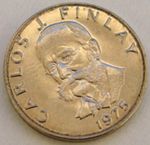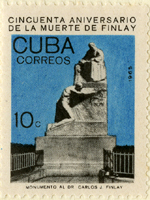 Carlos Juan Finlay (1833-1915) was born in Cuba of European parents. He was sent to the Continent at the age of eleven for boarding school and then arrived in 1853 at the Jefferson Medical College of Philadelphia to earn his medical degree. While at Jefferson, Dr. Finlay studied with John Mitchell, MD and his son, Dr. S. Weir Mitchell, both early proponents of germ theory. Then, like many of his generation, Dr. Finlay spent time traveling and studying at various hospitals and clinics to specialize in ophthalmology. By 1864 Dr. Finlay returned to Havana, Cuba to practice medicine.
Carlos Juan Finlay (1833-1915) was born in Cuba of European parents. He was sent to the Continent at the age of eleven for boarding school and then arrived in 1853 at the Jefferson Medical College of Philadelphia to earn his medical degree. While at Jefferson, Dr. Finlay studied with John Mitchell, MD and his son, Dr. S. Weir Mitchell, both early proponents of germ theory. Then, like many of his generation, Dr. Finlay spent time traveling and studying at various hospitals and clinics to specialize in ophthalmology. By 1864 Dr. Finlay returned to Havana, Cuba to practice medicine.
Dr. Finlay’s interest in public health began in 1867 during a cholera outbreak. He then chose to focus on yellow fever, a particularly deadly virus during this period. In its final stage “yellow jack,” as it was sometimes called, would cause fever, jaundice, seizures, liver and kidney failure, and bleeding from mouth, nose and even eyes. Between 1872 and 1879 Dr. Finlay published a series of findings about the disease and was eventually recognized as a foremost authority. He was appointed by the Cuban government to work with the United States Commission on Yellow Fever and he served in the Cuban government itself on committees meant to study and eradicate the disease.
 On August 14, 1881, Dr. Finlay presented a paper theorizing that the mosquito (Aedes aegypti) was the vector for the disease. His theory was the first to suggest that there was an intermediary agent causing yellow fever. The reaction from the medical community was disbelief. For the next 19 years, Dr. Finlay spent countless hours attempting to convince his fellow physicians of his findings. In 1900, American Walter Reed, MD and his commission finally confirmed Dr. Finlay’s experiments and he was named the Chief Sanitary Officer of Cuba from 1902 to 1909.
On August 14, 1881, Dr. Finlay presented a paper theorizing that the mosquito (Aedes aegypti) was the vector for the disease. His theory was the first to suggest that there was an intermediary agent causing yellow fever. The reaction from the medical community was disbelief. For the next 19 years, Dr. Finlay spent countless hours attempting to convince his fellow physicians of his findings. In 1900, American Walter Reed, MD and his commission finally confirmed Dr. Finlay’s experiments and he was named the Chief Sanitary Officer of Cuba from 1902 to 1909.
Dr. Finlay’s discovery was, and still is, considered exceptional. The American General Leonard Wood noted, “The confirmation of Dr. Finlay’s doctrine is the greatest step forward made in medical science since [Edward] Jenner’s discovery of vaccination.”